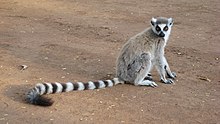
Back ليمور حلقي الذيل Arabic ليمور حلقى الذيل ARZ Bancudol (Lemur catta) AVK Котешки лемур Bulgarian Lemur catta Breton Prstenorepi lemur BS Lèmur de cua anellada Catalan Lemur catta CEB Lemur kata Czech Кушак лемурӗ CV
| Ring tailed lemur | |
|---|---|

| |
| Scientific classification | |
| Domain: | Eukaryota |
| Kingdom: | Animalia |
| Phylum: | Chordata |
| Class: | Mammalia |
| Order: | Primates |
| Suborder: | Strepsirrhini |
| Family: | Lemuridae |
| Genus: | Lemur Linnaeus, 1758 |
| Species: | L. catta
|
| Binomial name | |
| Lemur catta | |

| |
| Distribution of Lemur catta | |
| Synonyms | |
|
Genus:[1]
Species:[1]
| |
The ring-tailed lemur (Lemur catta) is a primate from the group of lemurs (Lemuriformes). It lives in the dry regions of southwest Madagascar.
This lemur weighs between 2 to 3.5 kilograms (4.4 to 7.7 lb). It can live up to 20 years. [2] It is a mid-sized lemur. The striped tail makes it easy to recognize. Its behaviour is somewhat unusual for lemurs: it is active during the day, and spends much time on the ground. Ring-tailed lemurs live in groups of 12 to 15 animals. Each group is led by a female. Ring-tailed lemurs eat both meat and plants, but they mainly eat fruit. They live only in Madagascar. The main threats to ring-tailed lemurs are destroying the places where it lives and hunting.
- ↑ 1.0 1.1 1.2 1.3 1.4 Tattersall 1982, pp. 43–46.
- ↑ Hannover Zoo: Ring-tailed lemur Archived 2012-07-13 at the Wayback Machine, viewed 2012-12-06
<ref group=N> tags on this page, but the references will not show without a {{reflist|group=N}} template (see the help page).
